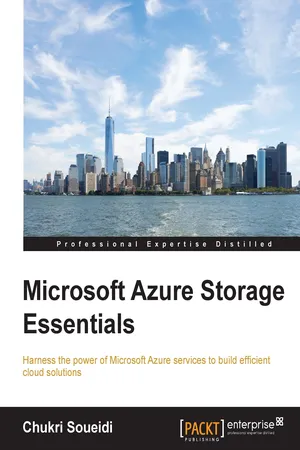
- 126 pages
- English
- ePUB (mobile friendly)
- Available on iOS & Android
Microsoft Azure Storage Essentials
About This Book
Harness the power of Microsoft Azure services to build efficient cloud solutions
About This Book
- Get to grips with the features of Microsoft Azure in terms of Blob, Table, Queue, and File storage
- Learn the how and when of using the right storage service for different business use cases
- Make use of Azure storage services in various languages with this fast-paced and easy-to-follow guide
Who This Book Is For
If you are an IT professional with basic knowledge of Microsoft Azure and want to learn Azure storage services, then this book is for you. Some familiarity with C# and Visual Studio is needed in order to utilize the examples present in the book.
What You Will Learn
- Get familiar with Windows Azure Storage Service in terms of architecture and working
- Recognize the libraries and tools offered by Azure storage, supporting several popular programming languages
- Know how the storage services expose their resources as REST APIs and what client libraries exists to develop against the storage
- Gain the understanding of types of Blobs and best ways to upload and retrieve them
- Learn how to make use of Tables as a NoSQL data store and how to retrieve, insert, update and delete entities in terms of design patterns
- Use Queue storage as a messaging solution for communications between different apps
- Create mounted shares and allow legacy systems to access data using the SMB protocol
- Get accustomed to deal with faults, monitor storage metrics and logs
In Detail
With the many advantages of using cloud computing, Azure Storage is a robust platform that helps you shift faster to the cloud by providing scalable, durable and highly available data storage options. For developers, it provides a rapid development environment that supports building large-scale applications to support new scenarios on the cloud, server, mobile and web. For IT professionals, it reduces complexity of managing, protecting and replicating data.
This book will make you familiar with the Azure storage in terms of architecture and components. It starts with the basics of storage accounts, which give access to the four basic services the Blob, Table, Queue, and File storage services. These services are exposed through a REST API that makes it possible for client libraries to implement most of their functionality in a wide range of popular programming languages. Emphasizing the Windows Azure Client Library for.NET, we will deal with storing and retrieving unstructured data with Blobs, then will move to Tables to insert and update entities in a structured NoSQL fashion. Then we will discover Queues as a reliable messaging service, and after that we will show File storage that allows you to migrate legacy applications data to the cloud to end with transient fault handling and service monitoring.
Style and approach
This book is a concise and fast-paced guide to learn about development for storage services. Each topic is elaborated sequentially, in order to create basic knowledge for using it in the right place and the correct way.
Frequently asked questions
Information
Microsoft Azure Storage Essentials
Table of Contents
Microsoft Azure Storage Essentials
Table of contents
- Microsoft Azure Storage Essentials